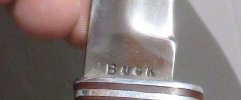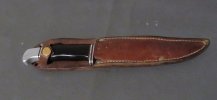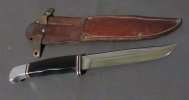bertl
Gold Member
- Joined
- Feb 17, 2011
- Messages
- 2,225
The knife in the photos just sold on the internet for quite a bit (I didn't end up with it.). The seller described it as a late Group 1 or early Group 2 with a black masonite handle. Based on the sheath, that's probably a good description, but I don't think it fits for the knife. The tang stamp would be more or less correct, but the guard and pommel spacers put the knife at a much later time. I wonder if the handle is actually ebony, or even phenolic, instead of masonite (I don't think you can tell from the photos.)
Please comment.
Bert



Please comment.
Bert







